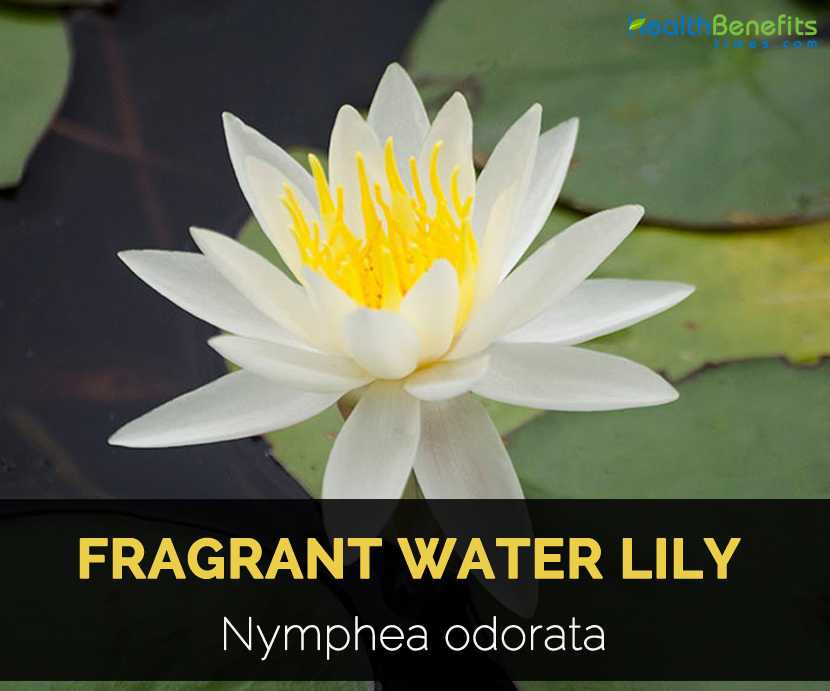| Fragrant Water Lily Quick Facts | |
|---|---|
| Name: | Fragrant Water Lily |
| Scientific Name: | Nymphea odorata |
| Name | Fragrant Water Lily |
|---|---|
| Scientific Name | Nymphea odorata |
| Common/English Name | White pond lily, Water Cabbage, Water Nymph, Sweet Scented Pond Lily, Cow Lily, American white waterlily, cow cabbage, fragrant water lily, sweet scented water lily, sweet water lily, toad lily, water cabbage, water nymph, white pond lily, white water lily |
| Flowering Season | Summer and early fall |
| Flower | White, showy and fragrant, 6 inches in diameter |
| Medicinal part | The root |
Uses
An old-fashioned home remedy brought into use by the Indians, the knowledge of which has been passed down for generations. There are few remedies which act more promptly than this in old cases of leucorrhoea, where there is chronic inflammation of the womb or abrasion of the vagina, and for ulceration of the womb it has proven efficacious, having completely cured the disease after all other available means have failed. It should be used locally, by injection of the infusion to the neck of the womb, and taken internally. Very accommodating in cases of dropsy and kidney trouble, catarrh of the bladder, irritation of the prostate. Has been used largely for diarrhoea and bowel complaints, excellent for infant diarrhoea, scrofula and diseases of the lungs. The infusion is healing to sores, ulcerated mouth, inflamed gum, canker, sore throat.
Dose
1 oz. of the root boiled in 1 pint of water for 20 min., taken from wineglassful to teacupful amounts two or three times a day. Of the fluid extract, 10–15 drops, morning and night.
Externally
The fresh juice of the root mixed with lemon juice is excellent for removing freckles, pimples and dark discolorations of the skin. Make a strong tea for use as a local application applied with Turkish towels, or white cotton, for painful swellings, boils, ulcers, etc. The bruised leaves are healing to wounds and cuts applied as poultice.
Homoeopathic Clinical
Tincture of the root—Back (pain in), Coryza, Diarrhoea, Throat (sore).
Russian Experience
In Russian literature mention is made of two kinds of Pond lily—Kuvshinka Nymphaea alba and Nymphaea candida. They are slightly different but used medically the same way. In some undisturbed areas of ponds, lakes and slow-running water up to 6 ft. deep, Lily’s will cover the peaceful surface.
Folk Medicine use both species as astringent for female trouble of amenorrhoea.
Clinically
The rhizome is used medically for palilloma of the kidney and acidic gastritis.
Culinary uses
- Flower buds are cooked as vegetables or pickled.
- Young flower are consumed raw.
- Leaves are consumed raw or cooked.
- It is used in soups and stews.
- Roots are boiled or roasted.
- Ripe seeds are cooked or ground into a meal.
Medicinal uses
- Roots tea is used for treating TB, diarrhea, chronic bronchial complaints, inflamed glands, gonorrhea, mouth sores and stop bleeding.
- Root poultice is used for treating boils, swellings, inflamed skin, vaginitis and tumors.
References:
https://plants.usda.gov/core/profile?symbol=NYOD
https://aquaplant.tamu.edu/plant-identification/alphabetical-index/water-lily/white-water-lily/
http://www.naturalmedicinalherbs.net/herbs/n/nymphaea-odorata=fragrant-water-lily.php
https://botanical.com/botanical/mgmh/l/lilwhi26.html
https://juniperpublishers.com/apbij/pdf/APBIJ.MS.ID.555647.pdf
Comments
comments
